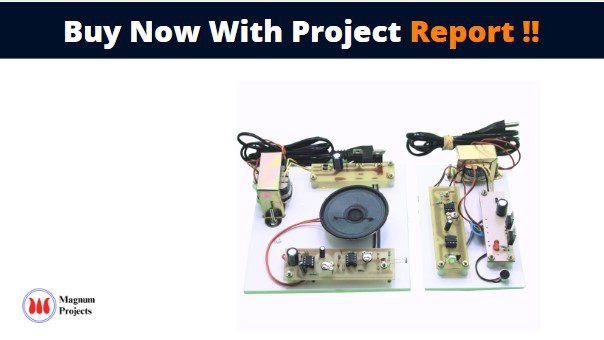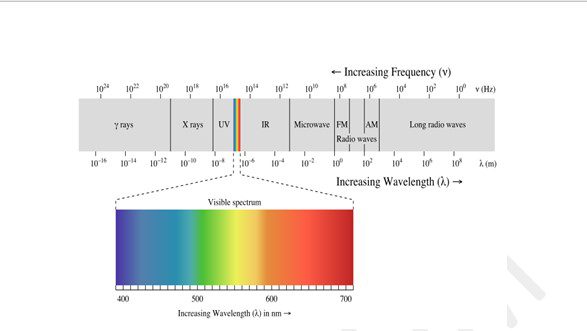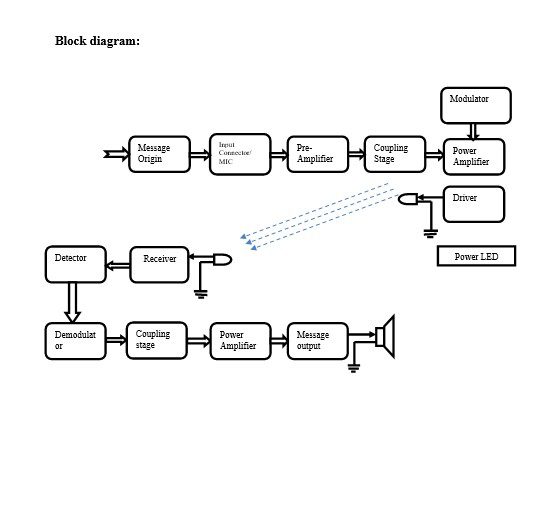Table of Contents
Introduction:

Visible light is the form in which electromagnetic radiation with wavelengths in a particular range is interpreted by the human brain. Visible light is thus by definition comprised of visually-perceivable electromagnetic waves. The visible spectrum covers wavelengths from 380 nm to 750 nm.
Figure 1: shows for each wavelength the associated color tone as perceived by
human beings.

Fig 1:The visible spectrum
At the lower end of the spectrum there are violet-bluish tones and light at the other end of the spectrum is interpreted to be distinctly red. Note that some animals exist whose vision merges into the ultraviolet (< 380 nm) or the infrared (> 750 nm).
Visible light communications (VLC) can provide cable-free communication at very high bit rates as high as 100Mbps. In addition, it has a major advantage in that it causes no interference to RF-based devices. This made wireless communication possible in RF-hazardous areas such as hospitals and space stations. In addition to these two key advantages, safety, simple installation procedures, and band licensing-free characteristics also helped increase VLC’s potential to be developed as an alternative, or even a new standard to the wireless communication scheme.

Fig 2: Visible Spectrum Showing Wavelength

Block-Diagram Explanation
A VLC system used to transmit high-quality video and audio signals was proposed and demonstrated by using illumination LEDs. The analog signals were transmitted using the illumination LEDs in the transmitter. The photodiode at the receiver senses optical signals from the LEDs and is converted into electrical signals. The electrical signal is then amplified to recover the digital signal and converted back to analog signals. To obtain this signal is amplified to increase the strength such that it will drive the preceding stage such as power LED and its driver and to remove noise capacitor filter is used.
This project can make use of Light as a source of medium to transmit the signals as it is known that light is ambient and it doesn’t affect human life or nature here we are transmitting the audio signals via light.
Audio Communication
In the process of voice communication through the visible light on the transmitter side voice is used as the input signal. This signal is converted to an electrical signal through a condenser or microphone. This electrical signal is amplified by the amplifier circuits and fed into the power LED. The light signal from the LED varies according to the intensity of the voice signal. The louder the voice the glow of the LED will be. At the receiver side light dependant resister will receive the light signal and correspondingly generate an electrical signal proportional to it. This electrical signal is processed by a demodulator circuit, which is then fed to a speaker and produces the audio signal which was at the input of the transmitter side.
Methodology
- OFDM
OFDM is a popular multi-carrier modulation technique developed for RF systems able to significantly increase the data rate in bandwidth-constrained channels. Because of its outstanding performance in RF systems, modified forms of it, such as DC-biased optical OFDM (DCO-OFDM) and asymmetrically clipped optical OFDM (ACO-OCDMA), have been proposed for use in indoor VLC systems. Bit rates of 1 Gb/s in combination
Several challenges remain in using OFDM for VLC. The tails of the impulse response can be quite long, requiring a long cyclic prefix for OFDM to work, and this reduces the throughput. Dimming is another challenge in utilizing OFDM in indoor VLC. OFDM has a naturally high PAPR, but it is not easily controllable. A solution for embedding the dimming function in OFDM is to combine it with PWM, as suggested, but this approach limits the data rate and can cause a flicker. By far the worst problem for OFDM is the LED nonlinearity since, due to the large PAPR; it can severely distort the output signal.
2. SPATIAL MODULATION
To side-step the single-degree-of-freedom limitation of IM, a multi-point system can be used. The resulting so-called spatial modulation (SM) increases the data transmission rate by using multiple physically-separated transmitters and multiple physically-separated receivers. SM can either be used as a stand-alone modulation or be considered as a form of multiple-input multiple-output (MIMO) that can be combined with other modulation schemes to increase the bit rate.
The main drawback of SM in the VLC system is its susceptibility to shadowing and multipath interference.
Applications
- Smart lighting
- Mobile connectivity
- Hazardous environments
- Defense & Security
- Hospitals & Healthcare
- Wi-Fi spectrum relief
- Underwater communications
- Location-based services
Advantages & Disadvantages
Advantages:
1. Harmless for the human body.
2. Data transmission by sockets of existing light fixtures.
3. Alleviation of problems associated with the radio frequency (RF) communication system.
4. Less energy consumption.
5. Increased security.
6. Compact integration of sensors through small dimensions.
7. Huge number of channels available without interfering with other sources.
8. Simple electronics such as the drive for the LEDs.
9. No influence on other sensitive equipment through radio waves.
Disadvantages
1. To transmit the data it should be in the line of sight.




